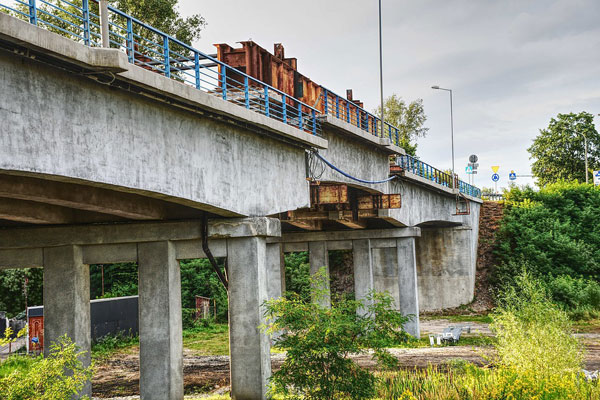In my first article “Significance of IBMS“, I mentioned the findings of IBMS (Indian Bridge Management System) wherein we had identified 145 bridges to have distress at the completion of 1st cycle. I also mentioned how no further action was taken on these findings. In my second article “Migration of IBMS to UBMS“, I stated that one of the reason we decided to strengthen the flow of activities in UBMS, (Unified Bridge Management System) was to ensure that identified bridges were attended to in a logical manner by confirmation of the prognosis, so that repair interventions are provided at appropriate times. One of the reasons why No action is initiated on the identification of distress is insufficient financial support to undertake repairs. If repairs are delayed at this stage, it would result in the bridge going from initial to moderate to severe distress and to critical stage. With continued delays in repair interventions, it will result in an imminent bridge collapse. If it does not collapse, soon a decision on a need to replace will have to be taken post closure of the bridge. Closure of bridges results in loss of continued connectivity. The cost escalation, of such neglect, is far more due to the risk of loss of human life should the bridge fail (Savitri bridge collapse). Even in case of bridge closure of bridges, the loss to the economy is far greater than the cost incurred during a timely repair intervention. UBMS ensures such a timely intervention.
ACTIVITIES FLOW OF UBMS
The flow of activities in UBMS, has been so modified that it results in undertaking proper activities which are logically essential. Post assignment of ratings in the inventory module of UBMS, the ratings are analysed for potential of distress in structure of the bridge or functional inadequacy or compromise in socio-economic parameters of the bridge. All these three parameters affect the safe, effective and efficient working of the bridge. Such bridges are assigned to a subset of bridges on that network which need intervention of either repairs, rehabilitation, strengthening or replacement. Unless further investigations are done, the possibility of a specific intervention is not possible to define. The detailed inspection of bridge enables: –
- The confirmation of ratings assigned in inventory
- Generally, defines the reason for distress.
A cause matrix is created to define the reason of distress. Cause matrix is based on a prognosis and is confirmed or rejected in the subsequent study which involves testing of the bridge structure. (Refer to my article “Importance of testing in IBMS”) Such a flow of activity ensures that the UBMS user logically moves from one step to the next by confirmation of what is evaluated in the first step. This brings in more qualitative efficiency in the activity flow. Once the testing confirms the prognosis as to the reason of distress, based on EN1504, the principle of repair is decided.
ESTIMATION OF BUDGET AND PRIORITY OF REMEDIAL ACTION FOR UBMS
The next immediate task post testing and confirmation of cause of distress is to define the principle of remedial action and evolve Budgetary estimate for the same.

This is done based on observations during the inspection process and based on the area (which is identified during the inspection process) where distress is observed. Presently under UBMS this procedure to estimate the quantity of repair is done manually by the engineer who undertakes the inspection and is confirmed by the engineer who does the testing. The plots of distress are generated by the inspection engineer. The testing engineer, post confirmation of prognosis, decides the principle of repairs and the details of the procedure to be adopted for repairs. He also decides on the items of works to be operated. Based on these items of work, the quantity of repairs is evolved for each item of work based on what type of work is involved. As implementation of Bridge Management is in its nascent stage in India, we still have not evolved any list of items to be adopted under each principle of repairs. Such an evolution happens with time, once the institutional authority responsible for bridges issues a codal procedure for each principle of repair. Once a code for standard operating procedures (SOP’s) for all principles of repairs are defined, the automation of this operation is possible and will bring increased efficiency in UBMS.

Priority assignment to which bridge needs urgent repairs is the next step. Such a priority is essential to be defined, as the total cost of undertaking repairs for all bridges may far exceed the financial support available for maintenance of bridges on any given network. In a scenario of limited budget, it is critical to define a protocol as to what will decide the priority. The estimated cost of remedial action is just one of the factors, which decide the priority to be assigned to the bridge. Many other factors decide the priority of the bridge. The severity of distress, risk of No action, socio-economic importance of the bridge, degree of functional adequacy, increased ADT being some of the factors. Based on the algorithm that assigns weighted importance to various factors that impact the priority, a list of bridges is generated based on priority to implement remedial action. UBMS adopts “First Repair Worst Damage” (FRWD) philosophy to assign ranking to bridges. The entire concept was defined by the author in a paper published in the nineties in the UK at an International conference on Repairs and retrofitting of structures under the title “FRWD Expounded” FRWD essentially isolates the severe damage areas, within a structure for which action is first initiated. Extrapolating this concept to bridges in a network, all bridges with severe distress are first identified for immediate action. So, it implies, that with passage of time, the Inventory rating of bridges will slowly move from lower numbers (below 5) to a median level (5 to 7) before the number moves to safe and No action essential band of higher than 7.
IMPACT OF FUNDS ON UBMS
Availability of adequate funds, to undertake sustained activity flow within UBMS, (Inventory, Inspection, Testing, Maintenance) and subsequent fund provisions for undertaking remedial action as per priority ensures the subsequent elimination of distress in all bridges.

Proper fund flows ensure that UBMS management protocol moves from FRWR to RAFS (Repair At First Sight), which is the ultimate goal of UBMS bringing in increased efficiency of UBMS. Fund flow in desirable adequacy enables UBMS to provide solutions to all bridges which show very severe distress on priority in the initial stages, before all bridges in this category are repaired. Once all the bridges with severe distress are attended to, the attention of UBMS shifts to the subset of bridges with less distress till all distress is eliminated on all bridges on the network. Simultaneously, bridges which have lower ratings for Functional and Socio-Economic parameters are also attended to by required intervention to improve the performance of the bridge on this index. To recap, the priority of bridges involves all three parameters of structural safety, functional adequacy and socio-economic importance of the bridge. Once all the bridges are attended to, all Inventory ratings will move to safe or No action band of ratings numbers above 7. Such a scenario, eventually renders the network safe and efficient. This situation is possible only with appropriate level of financial support to UBMS. Inadequate financial support results in prolonged durations of time to repair the subset of bridges with structural distress, functional inadequacy and socio-economic importance. Structural severity increases in bridges with structural distress, Functional inefficiency increases in bridges with marginal loss of functional adequacy with delay in providing required intervention. This could result in exponential increase in cost to repair the bridges with continued delay.
Proper financial support ensures smooth functioning of UBMS over years resulting in increasing efficiency in management of bridges.


EFFICIENCY OF UBMS
Efficiency of UBMS is directly dependent upon financial support. UBMS allows a five years period, in short term, to fine tune and establish the fund flow requirements for sustainability of management of bridges. Under long term UBMS can help in predicting deterioration over 15 to 20 years periods thereby allowing planning of budget over that period of time. Deterioration models under UBMS enable predictive analysis for propagation of distress. These models are specific for each bridge and depend on the type of distress, reason for distress, location of bridge, traffic increments, etc. Such analysis ensures proper estimation of how and where distress will increase and the period it will take to become critical. Deterioration models also can predict the risk involved on a bridge if the bridge is not provided any repair intervention. This allows UBMS to prioritize the bridge for immediate repair, or defer the repair intervention to a later date. UBMS enables clients to decide the level of financial support requirements over a short-term and long-term period.

CONCLUSION
UBMS is a bridge management system that is dependent on the level of financial support provided to the program to ensure sustainability. Once adequate financial support is provided, then UBMS ensures that the funds are utilized in an efficient manner. Such efficiency ensures that all critical bridges on the network are first rehabilitated using FRWD and subsequently once all bridges are safe, the protocol shifts from FRWD to RAFS. Deterioration modelling in UBMS ensures short-term and long-term prediction of fund requirements, risk quotient for the bridge and ensures that funds provided are best utilized. Having said that, one fact cannot be denied that unless adequate financial support is provided, UBMS cannot function efficiently and effectively.
About the author:

The article is authored by SACHIDANAND JOSHI, Emeritus Chair—IBMS @ IDDC Engineers Pvt. Ltd.
All of the author’s career has been devoted to the Rehabilitation of structures. He has been a team leader to over 2000 inspection, repair and rehabilitation projects. Having seen the various causes of distress so closely and the extent of damage and loss that is caused by ZERO maintenance of various structures, he decided to devote his energy to conceptualize a system that can avoid this scenario. From that urge to minimize distress, came his focus on Asset Management Program.
SACHIDANAND JOSHI is presently working passionately to implement Asset Management Programs in various facades of the Civil Engineering industry in India. The author has ha flair to conceptualize projects and get the team to complete the micro-planning.

